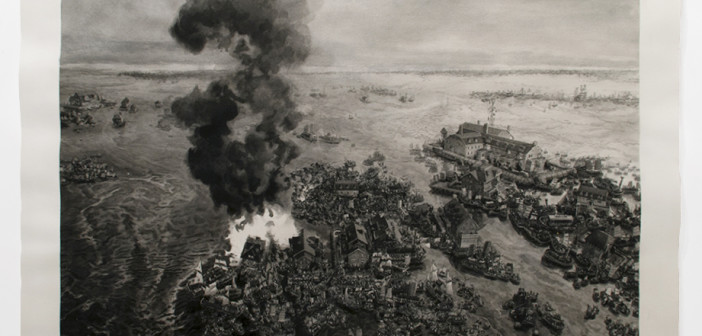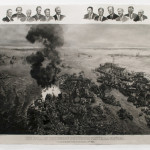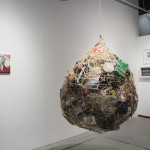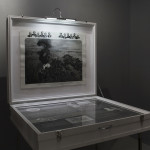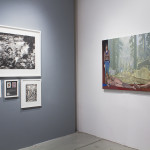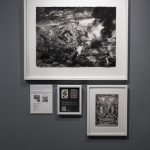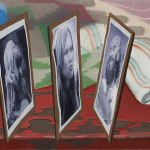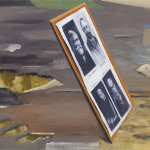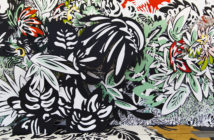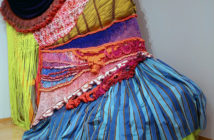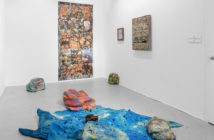"History is a malleable enterprise subject to the whims and desires of its writers." And, arguably, of its artists. Scott Patrick Wiener's curatorial statement for All Our Tomorrows and Yesterdays reveals his partiality, as an image-maker, for the documentary fallacies intrinsic to photography. The three person show, currently on view at Proof, juxtaposes the work of Mary Mattingly, Sean Downey, and Eric Petitti, none of whom are photographers, but all of whom persuasively engage with notions of the image/object as document.
 All Our Tomorrows and Yesterdays
All Our Tomorrows and YesterdaysForeground: Mary Mattingly, Terrene, 2012
Rope, twine, personal objects
3.5 feet in diameter
Spatially, the show revolves around Mary Mattingly’s sphere of collected belongings, the indiscriminate flotsam of her life, bound and hoisted off the floor with rope and twine. At three and a half feet in diameter, Terrene (2012) sags under its own weight, its height and bulk obstructing the view and restricting passage. Gentle oscillation and slow rotation unhurriedly reveal photographs, clothing, books and magazines… A bicycle light… A cluster of keys fastened to a miniature license-plate key-chain, which reads "Mary."
Mattingly anticipates the inevitable demise of objects she has come to own—their deaccessioning from the status of tool or accessory to that of refuse—by enabling their participation in the creation of a fetish object-archive, a portrait of the artist. The ordinariness of its contents, and our familiarity with them, triggers the same voyeuristic impulse as exploring someone else’s home, though the contents always remain just beyond our reach, absurd and unusable prisoners of the mass.
Terrene’s presence in the show serves as the most tangible reminder of mankind’s impact on the planet. To rephrase the title, our tomorrows will reflect our yesterdays, as possessions come to outlast their owners. Beyond measuring the material weight of her life thus far, Mattingly’s sculptural strategy deploys the aura of the art-object like a smokescreen in order to perform a sleight of hand. Before our very eyes, she transfers responsibility while she transfers ownership. Her burden is now ours.
Sean Downey’s work often depicts liminal spaces, somewhere on the cusp of a developed and a natural world—a polluted, desecrated frontier, botched attempts at contemporary edenic encampments. Characters come across as archetypes more than individuals, owing to their quasi-recognizable traits and dress, and this imbues the work with a sense of déjà-vu. But, beyond the subject matter itself, Downey’s strength lies in his use of form to tell an ongoing narrative, which is just as much about the object, and the process, of painting.
Some works, for instance, appear to use the act of representation to shift an object’s status from detritus to icon. The smaller Love Triangle (2013) and Four Members of the South Fork Fishing and Hunting Club (2013) each skew two-dimensional photographic planes, endowing them with enough heft to defy gravity. This has the uncanny effect of breathing life into the faces photographed: their gaze becomes active, interactive, significant once more. The printed document lives in a new context as a painted object.
Downey also seems highly attuned to the theatrics of the frame. In Go to School Go to School Drop Out Drop Out (2013), and thoughtACTIONthought, Best Wishes (2013), each composition is symmetrically centered on a scene that possesses the passive, empty quality of a stage-set. These are flanked with smaller scenes, which contain the most active elements of the composition. Skirting the canvas, they observe contradictory rules of perspective. As a result, there is no unified vision or space, no single illusion in which to lose oneself. This formal strategy gives a nod to the proscenium — the part of a theater stage which extends beyond the curtain — revealing and reveling in an awareness of the stagecraft of painting.
Eric Petitti is a meticulous fabricator of historical evidence, in service of one grand narrative of his own invention: The Dreadnaught Saga (2010 to present). Petitti’s ink and pencil drawings, of naval battles, propaganda posters, commemorative histories, and substantiating documents, are exquisitely accomplished. They provide rich and detailed insight into the world and times of the First Polar War, in 2535 CE, when the Antarctic Collective clashed with the Neothian Union over the loss of the ACS Golden Pear, its prized battleship. They also observe the rules and styles of previous works of art, which have immortalized the histories of those who could afford it.
 Eric Petitti
Eric PetittiThe Fall of the Great Flotilla Natori. (Installation View)
2013
Ink, Graphite, Inkjet Print.
52" x 38" x 35.5"
This work hovers between institutional critique, parody, and reverence, given Petitti’s interest in conflicting narratives and theories, and how he indulges in recreating museographic installations: cases, wall text, keys, even QR codes, expand on the saga, and deliberately render it even more confusing. All of the historical paraphernalia that turns us into collectors and fetishists is on display. At some point, however, he risks losing his audience. Petitti’s passion for the complexities of the story are clear, as is his attention to the structures that make a legend legitimate, but the methods come across as dry compared to the flamboyance of the tale. One can also critique the voice of the text, which wants to mimic that of history books, but misses for one reason or another. Placing emphasis on contradictory historical theories diverts attention from the more seductive visual elements with comparatively little reward. While still retaining its low-tech oddities, a more multi-sensory approach to the work would be fascinating to experience, and might permit a more rhythmic and captivating delivery to an audience already poised to believe the tale.
Beyond a few visual parallels, the artists in the show collectively don’t enhance one another as much as one might expect. In spite of their shared interest in the (historical) document as concept and aesthetic, and the convergence of past, future, and present possibilities in their work, their approaches differ vastly. Each shows a commitment and sophistication in the choice and understanding of material and medium which outweighs the conceptual thread of the show. So their grouping in All Our Tomorrows and Yesterdays, while ambitious, may not tease out the most compelling aspects of their work.
For one, Mattingly’s relationship to time seems more tangible and substantive than that of the others. Her body, which plays a strong part in some presentations and performances of these sculptures, is absent at Proof, save in a couple of cursory sketches. Suspending Terrene partly belies its weight, which is more evident in her physical interactions with other masses she has attempted to shift through space. Meanwhile, to become believable (and more humorous), Petitti’s saga, the most direct exploration of malleable histories, and exploitation of modes of authority in the creation of knowledge, really needs to be quarantined in a space it can colonize. As a result, Sean Downey’s work is what shines in the exhibition, because of its breadth, depth, and ability to draw links throughout the space. It extends itself toward Petitti’s though a shared voracity for images and their participation in mythologies, and toward Mattingly’s through shared acts of resistance in an encumbered world.
- Eric Petitti The Fall of the Great Flotilla Natori. (Detail) 2013 Ink, Graphite, Inkjet Print. 30″ x 22″
- All Our Tomorrows and Yesterdays Foreground: Mary Mattingly, Terrene, 2012 Rope, twine, personal objects 3.5 feet in diameter
- Eric Petitti The Fall of the Great Flotilla Natori. (Installation View) 2013 Ink, Graphite, Inkjet Print. 52″ x 38″ x 35.5″
- All Our Tomorrows and Yesterdays Proof, 2013 Installation view
- Sean Downey Go to School Go to School, Drop Out Drop Out 2013 oil on canvas 36 x 48 inches
- Eric Petitti The Casco Theory about the Missing Golden Pear. (Installation View) 2012 Ink, Graphite, inkjet prints. 53″ x 38″
- Sean Downey Love Triangle, 2013 Oil on canvas 12 x 16 inches
- Sean Downey Four Members of the South Fork Fishing and Hunting Club, 2013 Oil on canvas 12 x 16 inches
All Our Tomorrows and Yesterdays is on view at Proof until December 14, 2013
www.proof-gallery.com

